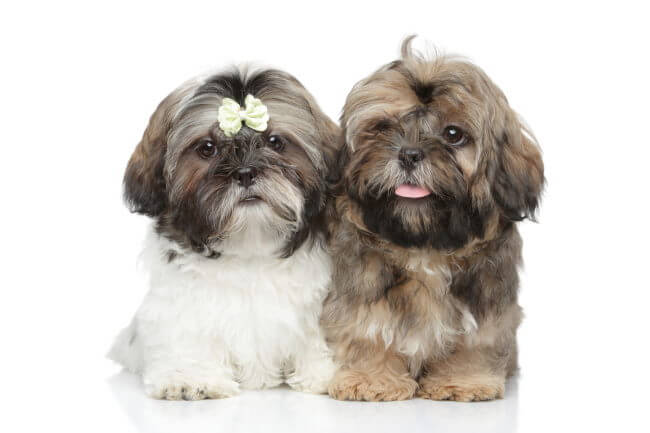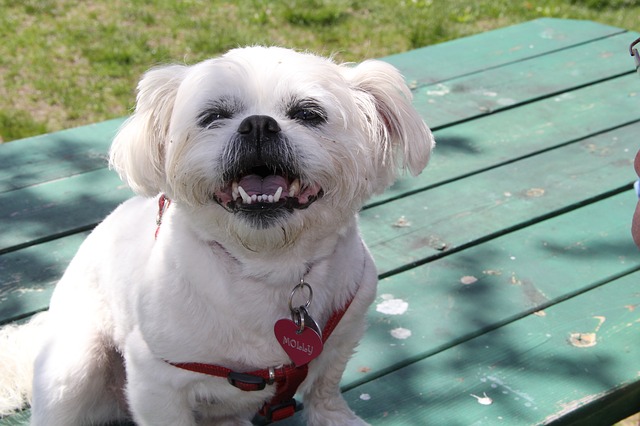Crate Training a Shih Tzu Puppy: How To Use a Crate to Potty Train Your New Puppy
BY MOLLY | EVERYTHINGSHIHTZU.COM
If you’re thinking about crate training your Shih Tzu puppy, here’s something you should know.
It’s a dog’s natural instinct, as a den animal, to want a place to sleep as well as provide a safe refuge for them. A crate will give them that den like comfort.
And as a bonus, your dogs crate can be very helpful for you too.

A crate can be used as a tool for potty training a puppy. But it does not do the training for you. You will still need to take your
leashed puppy outside frequently for potty breaks until they have built up their bladder and bowel control.
When crate training a puppy, it's important that the crate be only be large enough for the puppy to turn around in comfortably.
Any bigger and it could actually make it more difficult to potty train them properly.
If your puppy's crate is big enough where they can use a section of it for sleeping, and use another section for their bathroom breaks, this will defeat your goal, and it will certainly take longer for you to get the task done.
You’ll probably hear from people who will say “Crate training is horrible; the whole HOUSE should be their crate,” but honestly, that’s’ not always practical.
Like when you’re potty training a puppy, a crate is very effective.
Perhaps you work outside the home, and it’s simply not possible for you to be there all the time to put your puppy out, bring the dog in, put the dog out, bring the dog in--you get the idea.
Using a crate, therefore, would be pretty helpful.
Why Using a Crate Has Been Said to Be the Best Advice When It Comes To Potty Training a New Puppy
Crate training a puppy is quite simply the easiest, most successful method of potty training.
Dogs are den animals and crate training lets them know that this crate is their den, and their sleeping quarters.
My own Shih Tzu dogs have been completely potty trained for quite some time, but in the beginning the crate was a great tool we used when we first began training them.
They don't use their crates very much for sleeping anymore. Except when we go on vacation or have a lot of company, they need a calmer place to escape all the loud talking, laughing, and the feet of all these strange people in their home.
It's their quiet time and a safe place. And they have never used their crates as their own personal bathroom.
A dog will keep their den clean, and they instinctually know not to relieve themselves in it as they do not like sleeping in their own mess.
For potty training a puppy, ideally you’ll begin by crating most of the time.
This is simply because your puppy is going to think that if he’s in the same room with you, every corner is a potential potty zone if you’re not looking.
And once he or she messes in that corner, and gets away with it, that’s going to be the go-to spot no matter how much you clean.
You might not be able to smell the potty place after you’ve cleaned it, but your dogs nose is about a thousand times more sensitive than yours, and you can bet that he or she will remember.
A crate should not be used as punishment when trying to potty train your dog.
How To Potty Train Your Puppy with a Crate
Begin your crate training by being in the same place with your dog for as long as possible.
Ideally, new puppy owners should take a few days off work to begin training.
Put your puppy in the crate with the door closed and take him out every hour, to the spot where you want them to potty.
If you're training your puppy to do his business indoors, choose which room like the bathroom or mudroom, and put down some potty pads or newspapers for him to go on.
REMEMBER THIS:
Never use his crate as the place for him to potty.
Your puppy will want to keep the place where he or she sleeps clean and will learn to hold it until you take them out.
So crating, which is where they sleep, results in fewer accidents.
Make sure to take your puppy out first thing every morning, last thing at night, and any other time that he or she even looks like it might be a good time to potty.
How do you know? Circling and sniffing are signs that your baby wants to go.
 crate training a puppy
crate training a puppyFor Best Results Be Consistent
You should always water and feed at the same time every day.
Puppies learn quickly how to follow a schedule, and if he or she is fed and watered at the same time, potty time will also happen predictably.
If your puppy doesn’t potty immediately upon going out, take him inside and cuddle, but don’t put the furbaby down on the floor – this is a signal to relieve the bowels and bladder.
Take him or her outside, wait five minutes, and repeat as necessary.
When It Comes To Housetraining a Puppy, Patience Really Is a Virtue
Since your puppy is not a robot, it is pretty much guaranteed, he will have accidents in the house.
And when that happens, the last thing you should do is become angry or scold him, this is especially true if you don't catch him right when he is doing his deed.
That won’t encourage going outside – it’s just going to tell him that it would be better to hide the accident somewhere that you can’t see it.
Whether you’re paper-training or backyard training, if you use these tips when crate training a puppy, you’ll be assured of a clean home and a happy puppy.
You can’t ask for much more than that.



